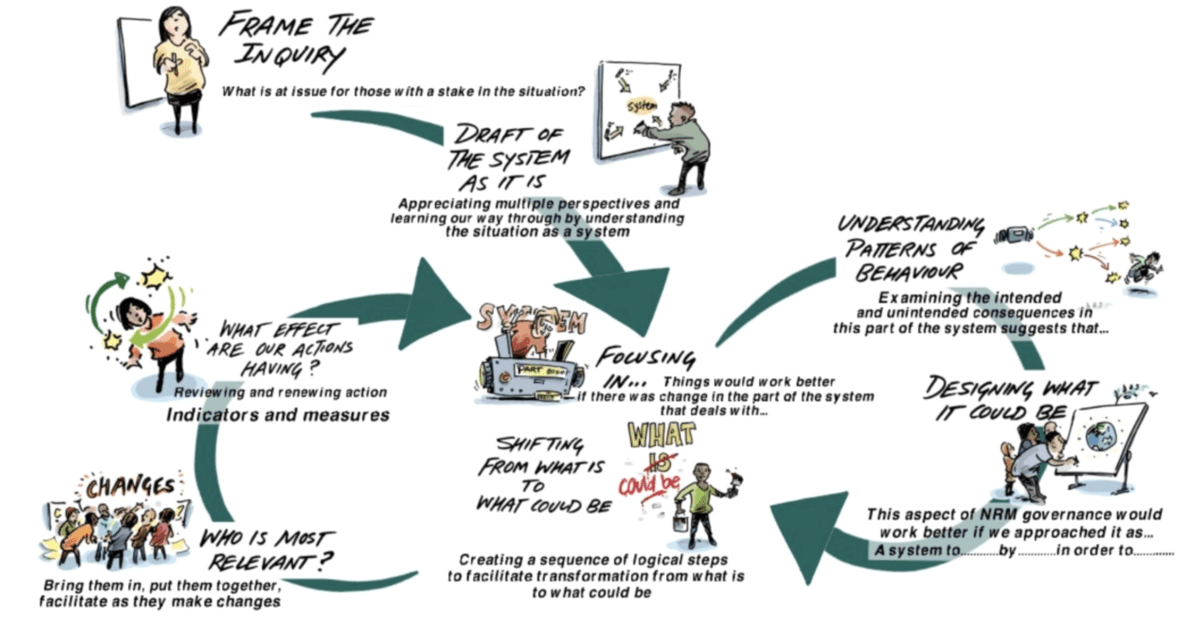TB872: Snappy Systems
Note: this is a post reflecting on one of the modules of my MSc in Systems Thinking in Practice. You can see all of the related posts in this category.

There is an animation included in the course materials for this module, from which I took the above image. The voiceover for the animation mentions that:
Multiple partial perspectives are needed to unpack experience complexity. Rich pictures based on experiences of a situation or snappy systems from SSM are useful methods for starting out. Both produce excellent mediating objects for sharing diverse and sometimes challenging perspectives. When done collaboratively, these help frame the inquiry.
The Open University (ibid.)
While we’ve been introduced to ‘rich pictures’ I can’t remember previous mention of ‘snappy systems’. So I looked it up. After wading through results relating to ‘systems’ for interlocking drill bits, I found this page from Triarchy Press, a “systems thinking publisher”. It appears to be either an extract from, or written to promote, a book called Growing Wings on the Way: Systems Thinking for Messy Situations by Rosalind Armson:
The idea of a system that does something and has a purpose, whether designed or attributed, provides a powerful way of understanding some of the complexity within a messy situation. ‘Snappy Systems’ is a technique for breaking out of taken-for-granted understandings of what something is or does. Snappy Systems is simply a rapid (hence ‘snappy’) way of generating a list of different ways of seeing something as a system with a purpose. Snappy Systems works well even if only one person is making the list but it works even better with a group of people contributing ideas.
Briefly, the approach comprises the following (Armson, n.d.):
- “Phase 1 of Snappy Systems is simply to list all the systems you can think of, as fast and uncritically as you can, that describe the [situation], by using the form ‘A [_____] is a system to [______]‘. Write down every item of your list, even if it seems silly or irrelevant.”
- “Phase 2 of Snappy Systems has two list-building stages. Firstly, list as many… stakeholders as possible. A stakeholder is anyone who might have a stake in – any reason for caring about – [the situation].”
- “Next, pick one of the stakeholders: it doesn’t really matter which one but it may work better if their stake is rather different from your own…Now repeat the Phase 1 process of listing systems but this time, do it from the perspective of your chosen stakeholder.”
- “Phase 3 of Snappy Systems – Sinister Systems – is optional but especially useful for exploring why things go wrong. This time the ideas-storm concentrates on systems causing things to go wrong. In other words, each system in the list has the ‘purpose‘ of creating unwanted effects.”
I can imagine this would be an extremely useful approach to use in a workshop, especially in-person. Armson goes on say:
Using Snappy Systems, and its variants, I begin to discern interlocking systems within the messy situation; the mess begins to acquire a structure. The idea that a system does something is closely allied to its purpose . ‘Doing something’ can be used as another way to clarify a messy situation by identifying systems within it. A system transforms something. The transformation it performs is the ‘doing something’ and is a key characteristic of the system. The system takes something in one state and transforms it into another state.
Armson (n.d.)
Returning to the image at the top of this post, I think it’s important to note that this is a slightly different approach to what I’ve been discussing in my posts recently. For example, it doesn’t really talk much about emotions, nor does it foreground the traditions of practice of the practitioners. As such, it seems to be more focused on the ‘E’ (Engaging), ‘C’ (Contextualising), and ‘M’ (Managing) balls than on the ‘B’ (Being).
That being said, organisations do tend to like a process diagram, as it reassures them that you know what you’re doing. I can’t imagine that most systemic inquiries would follow this exact approach, but it’s a convenient fiction for if you need to ‘sell’ a systemic approach.
References
- Armson, R. (n.d.). Snappy systems. Available at https://www.triarchypress.net/growing-wings—snappy-systems.html. (Accessed 24 January 2024)
- The Open University. (2021). ‘2.5.1 Taking a design turn in your practice’, TB872: Managing change with systems thinking in practice. Available at https://learn2.open.ac.uk/mod/oucontent/view.php?id=2171589§ion=2.5.1 (Accessed 24 January 2024).

